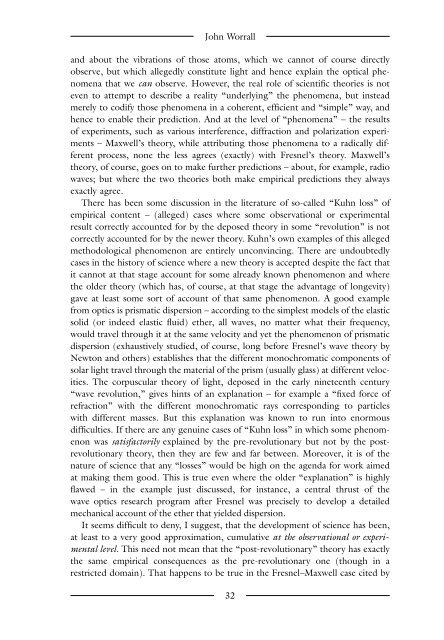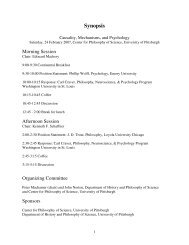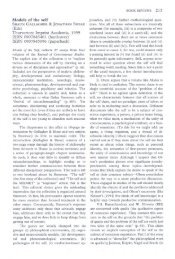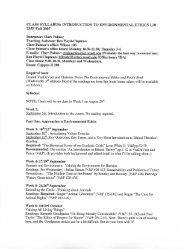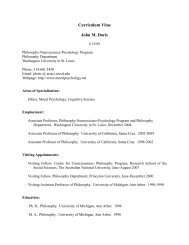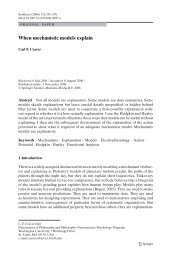The Blackwell Guide to the Philosophy of Science - The Department ...
The Blackwell Guide to the Philosophy of Science - The Department ...
The Blackwell Guide to the Philosophy of Science - The Department ...
Create successful ePaper yourself
Turn your PDF publications into a flip-book with our unique Google optimized e-Paper software.
John Worrall<br />
and about <strong>the</strong> vibrations <strong>of</strong> those a<strong>to</strong>ms, which we cannot <strong>of</strong> course directly<br />
observe, but which allegedly constitute light and hence explain <strong>the</strong> optical phenomena<br />
that we can observe. However, <strong>the</strong> real role <strong>of</strong> scientific <strong>the</strong>ories is not<br />
even <strong>to</strong> attempt <strong>to</strong> describe a reality “underlying” <strong>the</strong> phenomena, but instead<br />
merely <strong>to</strong> codify those phenomena in a coherent, efficient and “simple” way, and<br />
hence <strong>to</strong> enable <strong>the</strong>ir prediction. And at <strong>the</strong> level <strong>of</strong> “phenomena” – <strong>the</strong> results<br />
<strong>of</strong> experiments, such as various interference, diffraction and polarization experiments<br />
– Maxwell’s <strong>the</strong>ory, while attributing those phenomena <strong>to</strong> a radically different<br />
process, none <strong>the</strong> less agrees (exactly) with Fresnel’s <strong>the</strong>ory. Maxwell’s<br />
<strong>the</strong>ory, <strong>of</strong> course, goes on <strong>to</strong> make fur<strong>the</strong>r predictions – about, for example, radio<br />
waves; but where <strong>the</strong> two <strong>the</strong>ories both make empirical predictions <strong>the</strong>y always<br />
exactly agree.<br />
<strong>The</strong>re has been some discussion in <strong>the</strong> literature <strong>of</strong> so-called “Kuhn loss” <strong>of</strong><br />
empirical content – (alleged) cases where some observational or experimental<br />
result correctly accounted for by <strong>the</strong> deposed <strong>the</strong>ory in some “revolution” is not<br />
correctly accounted for by <strong>the</strong> newer <strong>the</strong>ory. Kuhn’s own examples <strong>of</strong> this alleged<br />
methodological phenomenon are entirely unconvincing. <strong>The</strong>re are undoubtedly<br />
cases in <strong>the</strong> his<strong>to</strong>ry <strong>of</strong> science where a new <strong>the</strong>ory is accepted despite <strong>the</strong> fact that<br />
it cannot at that stage account for some already known phenomenon and where<br />
<strong>the</strong> older <strong>the</strong>ory (which has, <strong>of</strong> course, at that stage <strong>the</strong> advantage <strong>of</strong> longevity)<br />
gave at least some sort <strong>of</strong> account <strong>of</strong> that same phenomenon. A good example<br />
from optics is prismatic dispersion – according <strong>to</strong> <strong>the</strong> simplest models <strong>of</strong> <strong>the</strong> elastic<br />
solid (or indeed elastic fluid) e<strong>the</strong>r, all waves, no matter what <strong>the</strong>ir frequency,<br />
would travel through it at <strong>the</strong> same velocity and yet <strong>the</strong> phenomenon <strong>of</strong> prismatic<br />
dispersion (exhaustively studied, <strong>of</strong> course, long before Fresnel’s wave <strong>the</strong>ory by<br />
New<strong>to</strong>n and o<strong>the</strong>rs) establishes that <strong>the</strong> different monochromatic components <strong>of</strong><br />
solar light travel through <strong>the</strong> material <strong>of</strong> <strong>the</strong> prism (usually glass) at different velocities.<br />
<strong>The</strong> corpuscular <strong>the</strong>ory <strong>of</strong> light, deposed in <strong>the</strong> early nineteenth century<br />
“wave revolution,” gives hints <strong>of</strong> an explanation – for example a “fixed force <strong>of</strong><br />
refraction” with <strong>the</strong> different monochromatic rays corresponding <strong>to</strong> particles<br />
with different masses. But this explanation was known <strong>to</strong> run in<strong>to</strong> enormous<br />
difficulties. If <strong>the</strong>re are any genuine cases <strong>of</strong> “Kuhn loss” in which some phenomenon<br />
was satisfac<strong>to</strong>rily explained by <strong>the</strong> pre-revolutionary but not by <strong>the</strong> postrevolutionary<br />
<strong>the</strong>ory, <strong>the</strong>n <strong>the</strong>y are few and far between. Moreover, it is <strong>of</strong> <strong>the</strong><br />
nature <strong>of</strong> science that any “losses” would be high on <strong>the</strong> agenda for work aimed<br />
at making <strong>the</strong>m good. This is true even where <strong>the</strong> older “explanation” is highly<br />
flawed – in <strong>the</strong> example just discussed, for instance, a central thrust <strong>of</strong> <strong>the</strong><br />
wave optics research program after Fresnel was precisely <strong>to</strong> develop a detailed<br />
mechanical account <strong>of</strong> <strong>the</strong> e<strong>the</strong>r that yielded dispersion.<br />
It seems difficult <strong>to</strong> deny, I suggest, that <strong>the</strong> development <strong>of</strong> science has been,<br />
at least <strong>to</strong> a very good approximation, cumulative at <strong>the</strong> observational or experimental<br />
level. This need not mean that <strong>the</strong> “post-revolutionary” <strong>the</strong>ory has exactly<br />
<strong>the</strong> same empirical consequences as <strong>the</strong> pre-revolutionary one (though in a<br />
restricted domain). That happens <strong>to</strong> be true in <strong>the</strong> Fresnel–Maxwell case cited by<br />
32


